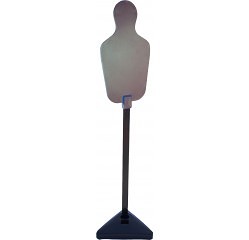There seems to be an ongoing industry-wide debate about which targets are best—paper or steel. While neither one will ever be crowned the ultimate victor, Action Target’s Steel Target Resource Guide gives meaningful insight to outline the strengths and weaknesses of each target type.
Paper
 Shooting on paper is a great way to sight-in rifles and score trainings, and is great for qualifications held by law enforcement agencies. Paper allows a shooter to see where shots land, illustrating how tight groups are. The NRA and other leading organizations use a lot of paper targets precisely for this reason. Another benefit of paper targets is that they provide a bigger variety of shapes, sizes, pictures, and scenarios (there are even a lot of zombie targets out now to add an extra element of fun to training). Each organization has its own types of score zones, stages, and qualification targets, so the wide variety of paper targets allows for greater flexibility between events. Many competitions use paper targets because of this flexibility.
Shooting on paper is a great way to sight-in rifles and score trainings, and is great for qualifications held by law enforcement agencies. Paper allows a shooter to see where shots land, illustrating how tight groups are. The NRA and other leading organizations use a lot of paper targets precisely for this reason. Another benefit of paper targets is that they provide a bigger variety of shapes, sizes, pictures, and scenarios (there are even a lot of zombie targets out now to add an extra element of fun to training). Each organization has its own types of score zones, stages, and qualification targets, so the wide variety of paper targets allows for greater flexibility between events. Many competitions use paper targets because of this flexibility.
Steel
One of the greatest benefits of using steel targets is the instant feedback they provide. Shooters can usually see and hear when they’ve hit a steel target and this is something that cannot be done when using a paper target. Whether the range is training civilians or law enforcement officials, steel targets help shooters know whether their intended target was hit or not. Hearing and reacting to the sound of a shot hitting a target helps program muscle memory, which reinforces positive behavior. 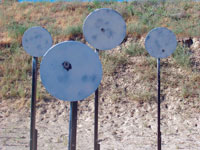 Just like in all athletic training, the body subconsciously remembers how to repeat or orchestrate all the different variables required for a successful movement, or in this case, shot. The ability that steel targets offer in regards to instantaneous feedback can actually enhance training, speed, and accuracy. This is especially important for tactical shooting scenarios with movement, such as moving plates and targets. Having multiple senses invoked during this training process conditions the shooter to become a more powerful and effective shooter.
Just like in all athletic training, the body subconsciously remembers how to repeat or orchestrate all the different variables required for a successful movement, or in this case, shot. The ability that steel targets offer in regards to instantaneous feedback can actually enhance training, speed, and accuracy. This is especially important for tactical shooting scenarios with movement, such as moving plates and targets. Having multiple senses invoked during this training process conditions the shooter to become a more powerful and effective shooter.
Another benefit of reactive steel targets is the pure entertainment factor. It may seem frivolous at first, but it can provide an enormous benefit to a training program. The fall, spin, bounce, and dodge of a target all lead to a fun and enjoyable experience for shooters of all skill levels. This will eventually lead to an increase in range use and therefore, an increase in profitability for the range.
So, should you shoot on paper or steel targets? In short, it depends on the purpose of the shooting exercise. As already discussed, if the purpose is for scoring, a paper target is best. However, if the shooter wants immediate feedback and would like to train on a more tactical level, steel targets are recommended. For more information on making the best decision, download Action Target’s Steel Resource Guide.







 The specific purpose of the Portable Target Course Book is to “ensure trainees a program that is designed to develop trainings that are safe, test fundamental skills, increase and enhance movement, improve the target selection thought processes, and enhance overall tactical awareness.” Action Target’s Portable Targets have become an industry standard and leader and the course book allows for a better overall training experience.
The specific purpose of the Portable Target Course Book is to “ensure trainees a program that is designed to develop trainings that are safe, test fundamental skills, increase and enhance movement, improve the target selection thought processes, and enhance overall tactical awareness.” Action Target’s Portable Targets have become an industry standard and leader and the course book allows for a better overall training experience.

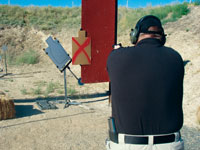 As part of the solution, we will follow a more flexible schedule in the types of courses Action Target Academy will offer to law enforcement. We have also designed new courses that demonstrate effective, yet budget friendly firearms trainings. For example, we will dramatically increase the number of our Portable Steel Target Seminars, which are held at outdoor ranges and taught by some of the best firearm instructors in the country. Some of these expert instructors include
As part of the solution, we will follow a more flexible schedule in the types of courses Action Target Academy will offer to law enforcement. We have also designed new courses that demonstrate effective, yet budget friendly firearms trainings. For example, we will dramatically increase the number of our Portable Steel Target Seminars, which are held at outdoor ranges and taught by some of the best firearm instructors in the country. Some of these expert instructors include 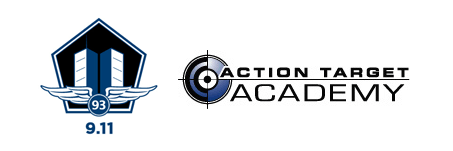
 One of the most visited of these staffed ranges is the Jay Henges range in High Ridge, MO, located outside St. Louis. Range Supervisor Jake Hindman estimates that the range, which opened in 1994, receives 20,000 shooters each year. This continual high volume of fire led to maintenance and containment concerns regarding the inevitable lead remediation on the dirt berms. These concerns caused the Department of Conservation to decide it was time to invest in a “Total Containment Range” to eliminate costly lead clean up and maintenance while ensuring that no fired bullets left the shooing range.
One of the most visited of these staffed ranges is the Jay Henges range in High Ridge, MO, located outside St. Louis. Range Supervisor Jake Hindman estimates that the range, which opened in 1994, receives 20,000 shooters each year. This continual high volume of fire led to maintenance and containment concerns regarding the inevitable lead remediation on the dirt berms. These concerns caused the Department of Conservation to decide it was time to invest in a “Total Containment Range” to eliminate costly lead clean up and maintenance while ensuring that no fired bullets left the shooing range.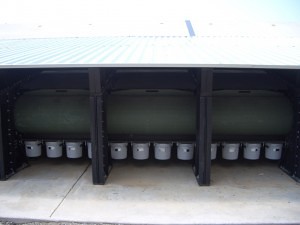 The Jay Henges Total Containment Trap measures 160 ft. wide with 20 shooting positions designed for heavy rifle use from the 100 yard firing line. The trap also features a unique self-supported engineered boom system that integrates into the frame of the bullet trap chambers, creating a support to the upper bullet trap plates without the need for a stand-alone truss system.
The Jay Henges Total Containment Trap measures 160 ft. wide with 20 shooting positions designed for heavy rifle use from the 100 yard firing line. The trap also features a unique self-supported engineered boom system that integrates into the frame of the bullet trap chambers, creating a support to the upper bullet trap plates without the need for a stand-alone truss system.
 Thanks again to everyone who participated in and helped make LETC 2011 a success! It is sincerely our privilege and honor to be able to work with the most dedicated, selfless, and hard-working members of the law enforcement community each year.
Thanks again to everyone who participated in and helped make LETC 2011 a success! It is sincerely our privilege and honor to be able to work with the most dedicated, selfless, and hard-working members of the law enforcement community each year.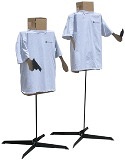 bounce, spin, rock, wobble, explode, fall, or give some other visual indicator when hit. High contrast paint on a shooting surface will increase visual feedback, but paint must be reapplied frequently. Paint can also be used to reduce visibility if desired.
bounce, spin, rock, wobble, explode, fall, or give some other visual indicator when hit. High contrast paint on a shooting surface will increase visual feedback, but paint must be reapplied frequently. Paint can also be used to reduce visibility if desired.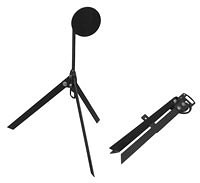 In addition to providing effective visible and audible indicators when hit, steel targets greatly enhance the steel efficiency of your training as well. Instead of changing out paper or cardboard targets, you can spend more time actually shooting. The 30 or so minutes you save each day really add up over the course of a year, especially if you are working with a large department.
In addition to providing effective visible and audible indicators when hit, steel targets greatly enhance the steel efficiency of your training as well. Instead of changing out paper or cardboard targets, you can spend more time actually shooting. The 30 or so minutes you save each day really add up over the course of a year, especially if you are working with a large department.
